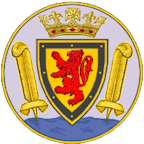History 1066 to 1200
Two years after the Norman Conquest, in 1068, there was a rebellion in the South-West, causing William the Conqueror to order that castles be built there. At this time, the Manor of Trematon was in the hands of William's half-brother Robert, the Count of Mortain. Robert chose for his castle a site about 1½ miles south-east of Trematon village, overlooking the Lynher estuary. The original castle defences consisted of earthworks and timber palisades. (The timber was later replaced by masonry: the keep in the 12th century and the bailey wall in the 13th.)
Trematon Castle became the administrative centre for the area, and Robert soon founded and promoted a weekly market outside the castle's gate. The Prior of the Saxon monastery and cathedral some two miles away at St Germans was not pleased, complaining that his own market was "reduced to nothing by reason of the market which the Count of Mortain has established hard by at a certain castle of his own."
In 1075 Robert ceded the Manor of Trematon to Richard de Valletort, a Norman knight who had fought at the Battle of Hastings. Hoping it would grow in conjunction with the market, Richard founded a borough in the vicinity of the castle. He also built a new parish church, dedicated to St Stephen, on the high ground across the valley from the castle.
The Domesday Book, completed in 1086, records: "Trematone ..... there are five hides. Arable land is 25 carucates in demesne and there are three carucates and 50 bondservi and 20 villeins and 30 borderers with 7 ploughs, 40 acres pasture and 20 acres wood formerly worth £10 now £8. The King has the castle and a market rendering 3/-". (Five hides is about 240 hectares or 600 acres. A carucate was the area a plough team could till in a year. Bondservi were servants who lived in the house of their lord and laboured at all kinds work without wages, being fed and clothed and transferred with the land. Villeins were also bound to the manor, but had the right to own about 30 acres of land, while borderers had land on the border of the manor to which they were bound.)
The ancient tin mining industry, which had been dormant since Roman times, was revived soon after the accession of Henry II in 1154. A local seaport had to be found for the shipment of the refined metal, and during Henry's reign Saltash developed as a major port exporting tin. The total extent of home and foreign trade cannot be estimated, but apart from shipments of tin it was undoubtedly small, and Saltash was to be eclipsed as a trading port by Plymouth before the year 1260.
In the late 12th century (about 1190) the de Valletorts, realising that the market and borough by Trematon Castle were failing to prosper because they were in an out-of-the-way location, decided to establish a new borough near the Tamar foreshore where a major land highway crossed a water highway – a much better position for trade.
This planned settlement was laid out on the hillside above the existing waterside community of fishermen and ferrymen. Part of the original ferry access route (now Culver Road) formed the southern boundary, and two new roads (now Albert Road and Fore Street / Lower Fore Street) were created running more or less parallel to it. More than a hundred building plots were set out, an area of relatively flat land amongst the surrounding steep gradients (now Alexandra Square) was reserved for a market place, and a large chapel dedicated to St Nicholas was erected on the eastern side of the market square. The parish church remained at St Stephens, the new St Nicholas's Chapel acting as a chapel of ease and as a community hall for the new borough.
Burgage (town property) rents lower than the manorial dues levied on the surrounding area encouraged people to settle in this new town of Esse, and we know that by the year 1201 the town had become well-established as a market and seaport borough, as the account of an Assize from that year mentions jurors coming from the Borough of Esse.
page updated 2016-06-07
